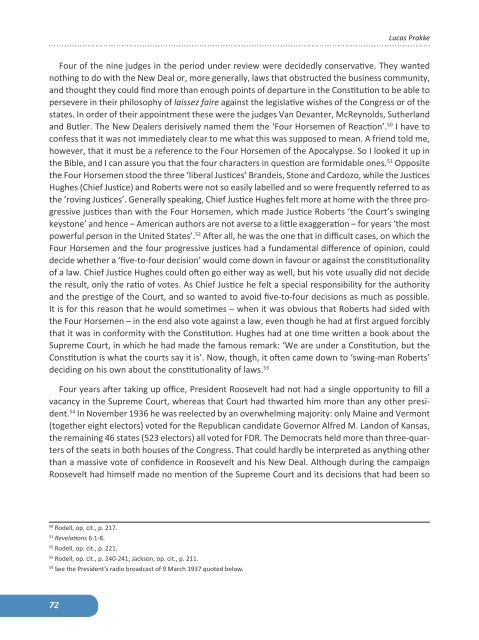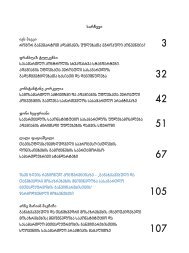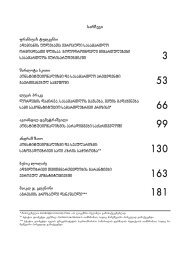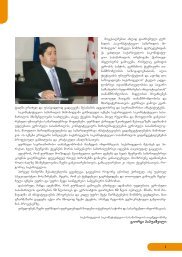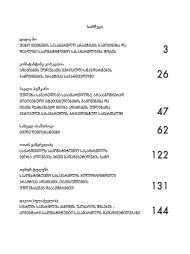Contents - Constitutional Court of Georgia
Contents - Constitutional Court of Georgia
Contents - Constitutional Court of Georgia
You also want an ePaper? Increase the reach of your titles
YUMPU automatically turns print PDFs into web optimized ePapers that Google loves.
72<br />
Lucas Prakke<br />
Four <strong>of</strong> the nine judges in the period under review were decidedly conservative. They wanted<br />
nothing to do with the New Deal or, more generally, laws that obstructed the business community,<br />
and thought they could find more than enough points <strong>of</strong> departure in the Constitution to be able to<br />
persevere in their philosophy <strong>of</strong> laissez faire against the legislative wishes <strong>of</strong> the Congress or <strong>of</strong> the<br />
states. In order <strong>of</strong> their appointment these were the judges Van Devanter, McReynolds, Sutherland<br />
and Butler. The New Dealers derisively named them the ‘Four Horsemen <strong>of</strong> Reaction’. 50 I have to<br />
confess that it was not immediately clear to me what this was supposed to mean. A friend told me,<br />
however, that it must be a reference to the Four Horsemen <strong>of</strong> the Apocalypse. So I looked it up in<br />
the Bible, and I can assure you that the four characters in question are formidable ones. 51 Opposite<br />
the Four Horsemen stood the three ‘liberal Justices’ Brandeis, Stone and Cardozo, while the Justices<br />
Hughes (Chief Justice) and Roberts were not so easily labelled and so were frequently referred to as<br />
the ‘roving Justices’. Generally speaking, Chief Justice Hughes felt more at home with the three progressive<br />
justices than with the Four Horsemen, which made Justice Roberts ‘the <strong>Court</strong>’s swinging<br />
keystone’ and hence – American authors are not averse to a little exaggeration – for years ‘the most<br />
powerful person in the United States’. 52 After all, he was the one that in difficult cases, on which the<br />
Four Horsemen and the four progressive justices had a fundamental difference <strong>of</strong> opinion, could<br />
decide whether a ‘five-to-four decision’ would come down in favour or against the constitutionality<br />
<strong>of</strong> a law. Chief Justice Hughes could <strong>of</strong>ten go either way as well, but his vote usually did not decide<br />
the result, only the ratio <strong>of</strong> votes. As Chief Justice he felt a special responsibility for the authority<br />
and the prestige <strong>of</strong> the <strong>Court</strong>, and so wanted to avoid five-to-four decisions as much as possible.<br />
It is for this reason that he would sometimes – when it was obvious that Roberts had sided with<br />
the Four Horsemen – in the end also vote against a law, even though he had at first argued forcibly<br />
that it was in conformity with the Constitution. Hughes had at one time written a book about the<br />
Supreme <strong>Court</strong>, in which he had made the famous remark: ‘We are under a Constitution, but the<br />
Constitution is what the courts say it is’. Now, though, it <strong>of</strong>ten came down to ‘swing-man Roberts’<br />
deciding on his own about the constitutionality <strong>of</strong> laws. 53<br />
Four years after taking up <strong>of</strong>fice, President Roosevelt had not had a single opportunity to fill a<br />
vacancy in the Supreme <strong>Court</strong>, whereas that <strong>Court</strong> had thwarted him more than any other president.<br />
54 In November 1936 he was reelected by an overwhelming majority: only Maine and Vermont<br />
(together eight electors) voted for the Republican candidate Governor Alfred M. Landon <strong>of</strong> Kansas,<br />
the remaining 46 states (523 electors) all voted for FDR. The Democrats held more than three-quarters<br />
<strong>of</strong> the seats in both houses <strong>of</strong> the Congress. That could hardly be interpreted as anything other<br />
than a massive vote <strong>of</strong> confidence in Roosevelt and his New Deal. Although during the campaign<br />
Roosevelt had himself made no mention <strong>of</strong> the Supreme <strong>Court</strong> and its decisions that had been so<br />
50 Rodell, op. cit., p. 217.<br />
51 Revelations 6:1-8.<br />
52 Rodell, op. cit., p. 221.<br />
53 Rodell, op. cit., p. 240-241; Jackson, op. cit., p. 211.<br />
54 See the President’s radio broadcast <strong>of</strong> 9 March 1937 quoted below.


